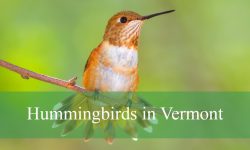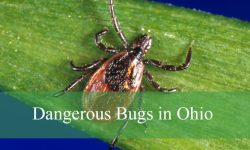Dragonflies in Massachusetts are among the most mesmerizing creatures to watch in nature. Alongside the delicate beauty of butterflies and the vibrant songs of birds, dragonflies offer their own spectacular display of colors and graceful flight. Their shimmering wings and swift movements bring life to ponds, lakes, and wetlands, making them a favorite for anyone who loves observing the outdoors.
The diversity of dragonflies in Massachusetts is truly impressive, featuring species with unique shapes, vivid colors, and fascinating behaviors. From the bold Common Green Darner to the tiny Eastern Amberwing with its glowing amber wings, these insects brighten the natural world while playing an important role as skilled hunters of flying insects like mosquitoes.
Exploring these 15 common dragonfly species found throughout Massachusetts will reveal a stunning variety of patterns and hues. This guide will help you identify and appreciate the elegance of these aerial acrobats, perfect for those who enjoy the beauty of nature’s flying gems.
Common Dragonflies Found in Massachusetts
Common Green Darner (Anax junius)

The Common Green Darner is one of the most recognizable and widespread dragonflies in Massachusetts. It belongs to the family Aeshnidae and is notable for its large size and striking coloration. Adults typically measure about 2.5 to 3 inches (6.3 to 7.6 cm) in length, making them one of the largest dragonflies in the region. Their vibrant green thorax contrasts with a blue abdomen tipped with black, giving them their characteristic look. The eyes are large and green, providing excellent vision during flight.
Identification of the Common Green Darner is relatively straightforward due to its distinctive color pattern and size. The green thorax is iridescent, while the abdomen shows bright blue segments with a thin black dorsal stripe. Wings are clear but may show subtle amber coloration near the base in mature males. Both males and females share similar coloration, though females tend to have a duller abdomen. Their strong and fast flight is often seen patrolling over ponds, lakes, and marshes.
Behaviorally, the Common Green Darner is known for its migratory habits. It is one of the few dragonfly species in North America that migrates southward in the fall and returns north in the spring. This migration helps it avoid cold winters in Massachusetts. Darner adults feed on flying insects, catching prey midair with great agility. They are active during the day and often fly high above water bodies, making use of their powerful wings.
In Massachusetts, the Common Green Darner thrives in freshwater habitats such as ponds, lakes, marshes, and slow-moving streams. They require clean water bodies for breeding, where females lay eggs on submerged vegetation. This species is distributed statewide during the warmer months, with sightings most frequent from late spring to early fall. Due to their migratory nature, their numbers may fluctuate seasonally but they remain a common and iconic dragonfly species in the state.
Blue Dasher (Pachydiplax longipennis)
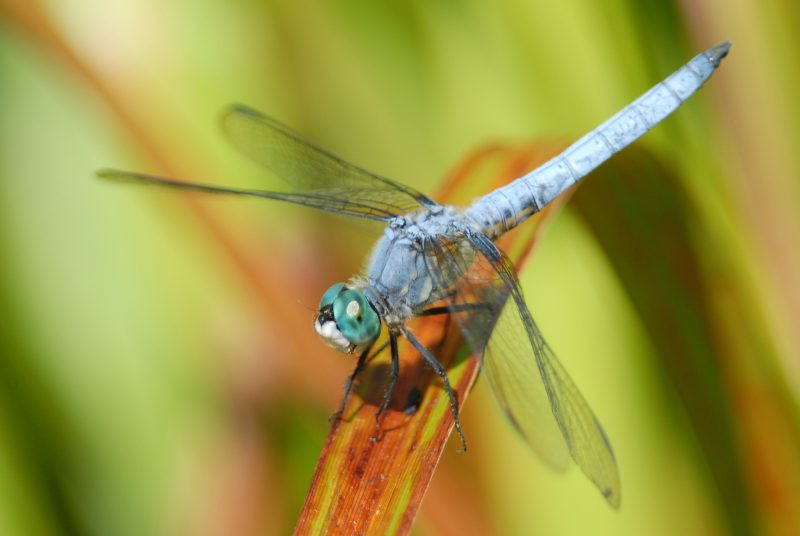
The Blue Dasher is a medium-sized dragonfly belonging to the family Libellulidae, known for its vivid coloration and distinctive body shape. Adults typically measure between 1.5 and 1.9 inches (3.8 to 4.8 cm) long. The males are especially striking with bright blue abdomens and yellow-striped thoraxes, while females show more muted olive-green and brown tones. The eyes of Blue Dashers are large and multifaceted, ranging in color from greenish to blue depending on age and sex.
Identification is made easier by the males’ brilliant powdery blue bodies and black wing markings at the bases of their wings. Females and immature males have yellow-striped abdomens with dark spots and a generally more camouflaged appearance. Wings are clear with dark patches near the base that stand out in flight. Blue Dashers have a stocky, compact build compared to more slender dragonflies, and their rapid, darting flight style is characteristic.
Blue Dashers are territorial and often perch conspicuously on reeds, logs, or vegetation near water edges. They defend their territories aggressively from rivals and potential predators. Their diet consists mainly of small flying insects caught on the wing. Blue Dashers are most active during warm, sunny days and can frequently be seen darting over ponds, marshes, and slow-moving streams in Massachusetts.
This species is common throughout Massachusetts, favoring calm freshwater habitats rich in aquatic vegetation for breeding. Females lay eggs on floating plants or submerged debris. Blue Dashers are especially abundant during the summer months, from late May through early September. Their adaptability to various freshwater environments makes them a frequent and familiar sight to dragonfly watchers in the state.
Halloween Pennant (Celithemis eponina)

The Halloween Pennant is a medium-sized dragonfly species in the family Libellulidae, instantly recognizable by its striking orange and black wing pattern reminiscent of a Halloween decoration. Adult individuals measure about 1.6 to 1.9 inches (4 to 5 cm) in length. Their wings display bold black spots and bands on an orange-yellow background, giving them their festive name. The body is slender and yellow with dark markings, with males and females similar in coloration.
This species can be identified easily by its distinctively patterned wings. Unlike many dragonflies with clear wings, the Halloween Pennant’s wings serve as camouflage and warning coloration, helping it blend with dried grasses and fallen leaves. The abdomen is yellowish with brown or black markings along its length. Their large compound eyes are reddish-brown to amber, aiding in keen vision.
Halloween Pennants exhibit a unique fluttering flight that resembles a pennant or flag waving in the breeze, often seen hovering or gliding over wetlands and grassy meadows. They are most active during sunny days and are known to perch on tall grasses or reeds with their wings spread wide, a behavior uncommon in many other dragonflies. Their feeding behavior focuses on small flying insects, and they use their excellent flight control to catch prey midair.
In Massachusetts, the Halloween Pennant prefers shallow ponds, marshes, and wet meadows with abundant emergent vegetation. They are typically found in the southern and central parts of the state during the summer months. Their preference for warmer habitats means sightings peak in July and August. Although not as common as some other species, the Halloween Pennant remains a favorite among dragonfly enthusiasts for its eye-catching wing patterns.
Eastern Pondhawk (Erythemis simplicicollis)
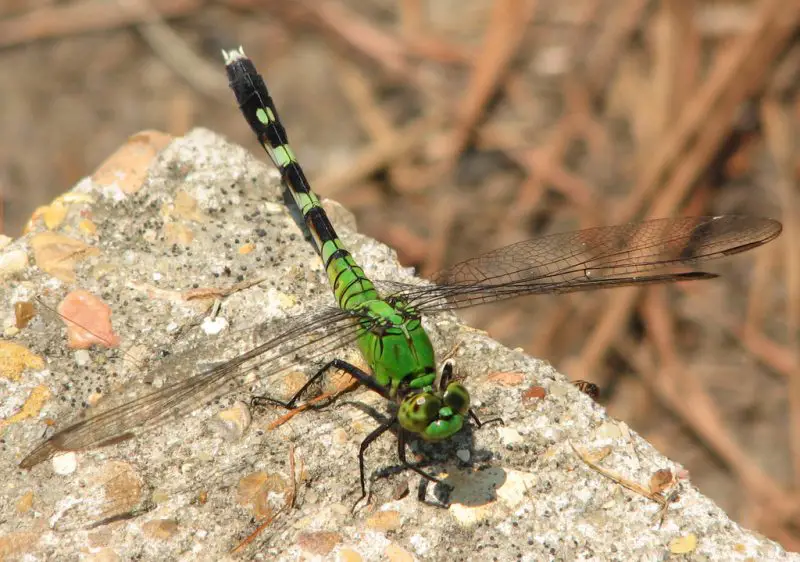
The Eastern Pondhawk is a medium-sized dragonfly species in the family Libellulidae, known for its vivid sexual dimorphism and widespread presence in Massachusetts. Adults range from 1.6 to 1.9 inches (4 to 4.8 cm) in length. Males are easily identified by their bright turquoise-blue bodies and green faces, while females and immature males are green with black markings. This species is characterized by its slender abdomen and clear wings.
Identification relies on observing the color differences between sexes. Mature males have powdery blue abdomens with black terminal segments, contrasting with their green thoraxes and faces. Females and immature males possess bright green bodies with dark triangular spots on each abdominal segment. Their wings are transparent and unmarked. The eyes are large and green, providing excellent visual acuity during flight.
Behaviorally, Eastern Pondhawks are aggressive territorial dragonflies frequently seen patrolling ponds, marshes, and slow streams. Males actively defend their territories by chasing intruders and engaging in aerial combat. They perch on vegetation or floating leaves and dart swiftly to capture flying insects. Their mating involves aerial copulation, and females lay eggs in calm water bodies with plenty of submerged vegetation.
In Massachusetts, Eastern Pondhawks are common throughout the state in suitable freshwater habitats during the warmer months, from late spring through early fall. They prefer ponds, lakes, and wetlands with abundant aquatic plants. This species’ adaptability and distinctive coloration make it one of the most commonly observed dragonflies in the region, often delighting both casual observers and enthusiasts alike.
Widow Skimmer (Libellula luctuosa)
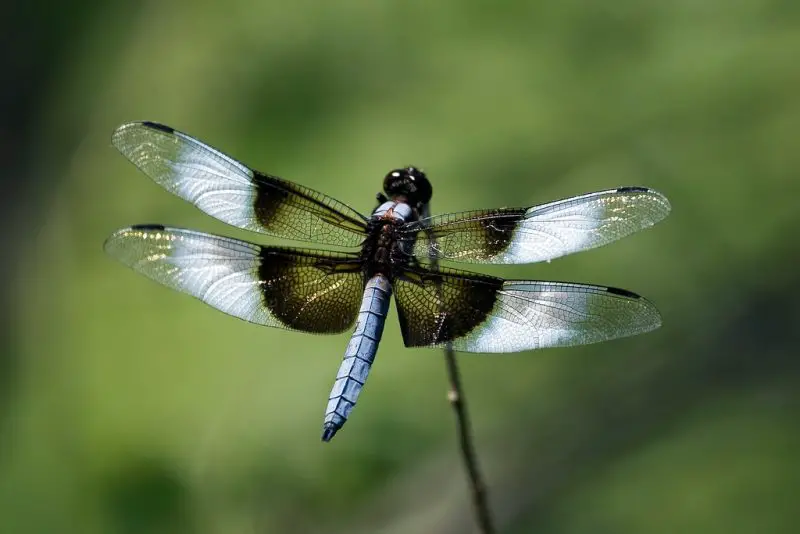
The Widow Skimmer is a medium to large dragonfly species of the family Libellulidae, measuring about 1.7 to 2.1 inches (4.3 to 5.3 cm) in length. This species is notable for its striking black-and-white wing pattern and robust body. Adult males have broad black basal wing patches with white spots adjacent, creating a dramatic contrast. Females have similar patterns but with more brownish tones. Their bodies are typically brown to dark gray with yellow markings on the abdomen.
Widow Skimmers can be identified by the distinctive wing markings, which are rare among dragonflies in Massachusetts. The males’ wings feature broad black patches at the base followed by white “windows” toward the middle. Females’ wings are more translucent with brownish patches but retain the distinctive pattern. The body is stout, and their large compound eyes range from brown to golden hues.
Behaviorally, Widow Skimmers are strong flyers often seen patrolling ponds, lakes, and slow rivers. Males establish and defend territories along the water’s edge by perching conspicuously on twigs or floating debris. They aggressively chase away rivals and predators. Their diet consists mainly of flying insects, which they catch with precise aerial maneuvers. The species is active during daylight hours, especially in warm sunny weather.
In Massachusetts, Widow Skimmers inhabit a variety of freshwater habitats, including ponds, lakes, marshes, and slow-moving streams with open sunny areas for hunting. They are found statewide, with peak activity from June through September. Their bold wing pattern and common presence make them a favorite species for identification among dragonfly watchers in the state.
Twelve-spotted Skimmer (Libellula pulchella)
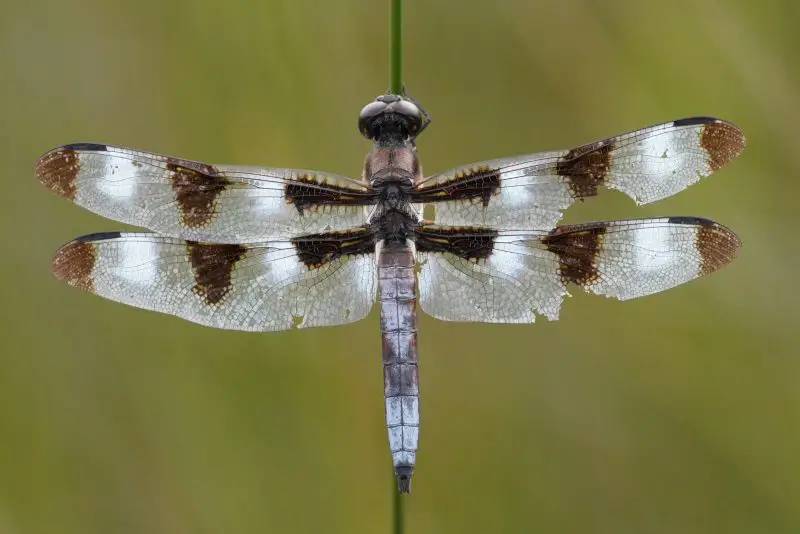
The Twelve-spotted Skimmer is a medium to large dragonfly species from the family Libellulidae, measuring approximately 1.8 to 2.2 inches (4.5 to 5.5 cm) in length. It is named for the distinctive pattern of twelve black spots on its wings, with three spots on each wing. The body is primarily brown to black with white spots on the abdomen that add to its striking appearance. Males are more conspicuous with white wing patches, while females have more subdued markings.
Identification of the Twelve-spotted Skimmer is fairly straightforward due to the unique wing spotting. Each wing displays three distinct black spots with white spots between them, giving the wings a checkered look when viewed in flight or at rest. The thorax is brown with pale stripes, and the abdomen is dark with white spots on the dorsal side. The eyes are large and brownish, providing excellent vision for hunting flying insects.
Behaviorally, this species is often seen patrolling open water bodies such as ponds, lakes, and slow streams. Twelve-spotted Skimmers are territorial and will aggressively defend their perches or breeding sites from intruders. They feed primarily on small flying insects, capturing them on the wing with agility and precision. Males perform elaborate flight displays to attract females during the breeding season.
In Massachusetts, the Twelve-spotted Skimmer is a common species found statewide from late spring to early fall. They prefer sunny, open habitats with still or slow-moving water rich in aquatic vegetation for egg laying. This species is adaptable and often seen basking on floating logs, rocks, or vegetation near water edges. Their distinctive wing pattern and active behavior make them a favorite among dragonfly observers in the region.
Black Saddlebags (Tramea lacerata)

The Black Saddlebags is a large and robust dragonfly species belonging to the family Libellulidae. Adults typically measure around 2 to 2.4 inches (5 to 6 cm) in length, making them one of the larger dragonflies in Massachusetts. Their most notable feature is the distinctive black “saddlebags”—dark patches at the base of the hindwings—which contrast sharply with the otherwise translucent wings. The body is reddish-brown or dark with a broad abdomen.
Identification is usually confirmed by the large black patches on the hindwings, resembling saddlebags, which are visible in both sexes. The thorax is brown with lighter stripes, and the abdomen is long and slender with a reddish or brownish tint. The eyes are large, dark, and set close together. When perched, Black Saddlebags often hold their wings slightly downward and out to the sides, showing off their distinctive wing markings.
Behaviorally, Black Saddlebags are strong fliers often seen patrolling large ponds, lakes, and marshes. They are capable of swift, acrobatic flight and are known to glide gracefully with their saddlebags clearly visible. This species feeds on a variety of flying insects and is active during warm, sunny days. Males defend territories aggressively near breeding sites, while females lay eggs by dipping their abdomens in the water during flight.
In Massachusetts, Black Saddlebags are most commonly found in wetlands and slow-moving waters with abundant emergent vegetation. Their presence is most noticeable in mid to late summer, from June through September. Though not as abundant as some other skimmers, their striking appearance and graceful flight make them a favored species for dragonfly watchers.
Spangled Skimmer (Libellula cyanea)

The Spangled Skimmer is a medium-sized dragonfly in the family Libellulidae, measuring about 1.5 to 1.8 inches (3.8 to 4.5 cm) long. It is named for the iridescent, metallic blue coloration on the males’ bodies, which shimmer in the sunlight like spangles or sequins. Females and immature males exhibit a yellowish-brown coloration with dark markings, making the sexual dimorphism quite pronounced.
Identification is highlighted by the males’ brilliant blue abdomen with black markings along the dorsal side. The thorax is blue with greenish hints, and the wings are clear with no distinctive markings. Females are less conspicuous, featuring a tawny or brownish body with darker stripes. Both sexes have large compound eyes, which are bluish in males and greenish-brown in females, enabling them to detect and capture prey efficiently.
Spangled Skimmers are active fliers commonly found patrolling ponds, marshes, and slow streams. They are territorial and perch prominently on reeds, rocks, or vegetation near water, often returning to the same perch repeatedly. Their diet consists of small flying insects caught midair, and they use rapid flight maneuvers to capture prey. Breeding involves aerial courtship displays and egg-laying in calm water with aquatic vegetation.
In Massachusetts, Spangled Skimmers are widespread and typically appear from late spring through early fall. They thrive in a variety of freshwater habitats, especially those with open, sunny water edges and abundant emergent plants. Their vibrant blue coloration and active behavior make them a popular species among dragonfly enthusiasts in the state.
Eastern Amberwing (Perithemis tenera)

The Eastern Amberwing is one of the smallest dragonflies in Massachusetts, belonging to the family Libellulidae. Adults measure only about 0.8 to 1 inch (2 to 2.5 cm) in length. They are named for their amber-colored wings, which are translucent with a warm orange hue. The body is slender and golden-yellow to reddish-brown, giving the species a delicate, almost jewel-like appearance.
Identification is straightforward due to the amber-tinted wings and small size. Both males and females have similarly colored wings and bodies, though females may be slightly paler. The thorax is golden-yellow with subtle brown markings, and the abdomen is narrow with alternating light and dark segments. Their large eyes are amber to golden, perfectly matching their wing color.
Eastern Amberwings are often found perched low on reeds, grasses, or floating vegetation near ponds, marshes, and slow-moving streams. They exhibit a fluttering flight style and are less aggressive than many other skimmers. Their diet consists primarily of tiny flying insects, which they catch in short, quick flights. Breeding behavior includes males guarding territories and females ovipositing eggs in submerged vegetation.
In Massachusetts, Eastern Amberwings are common in suitable wetland habitats statewide from late spring to early fall. Their small size and amber wings make them easy to overlook, but their numbers are plentiful where appropriate breeding sites exist. They contribute to the rich diversity of dragonflies in the state’s freshwater ecosystems.
Lancet Clubtail (Gomphus exilis)
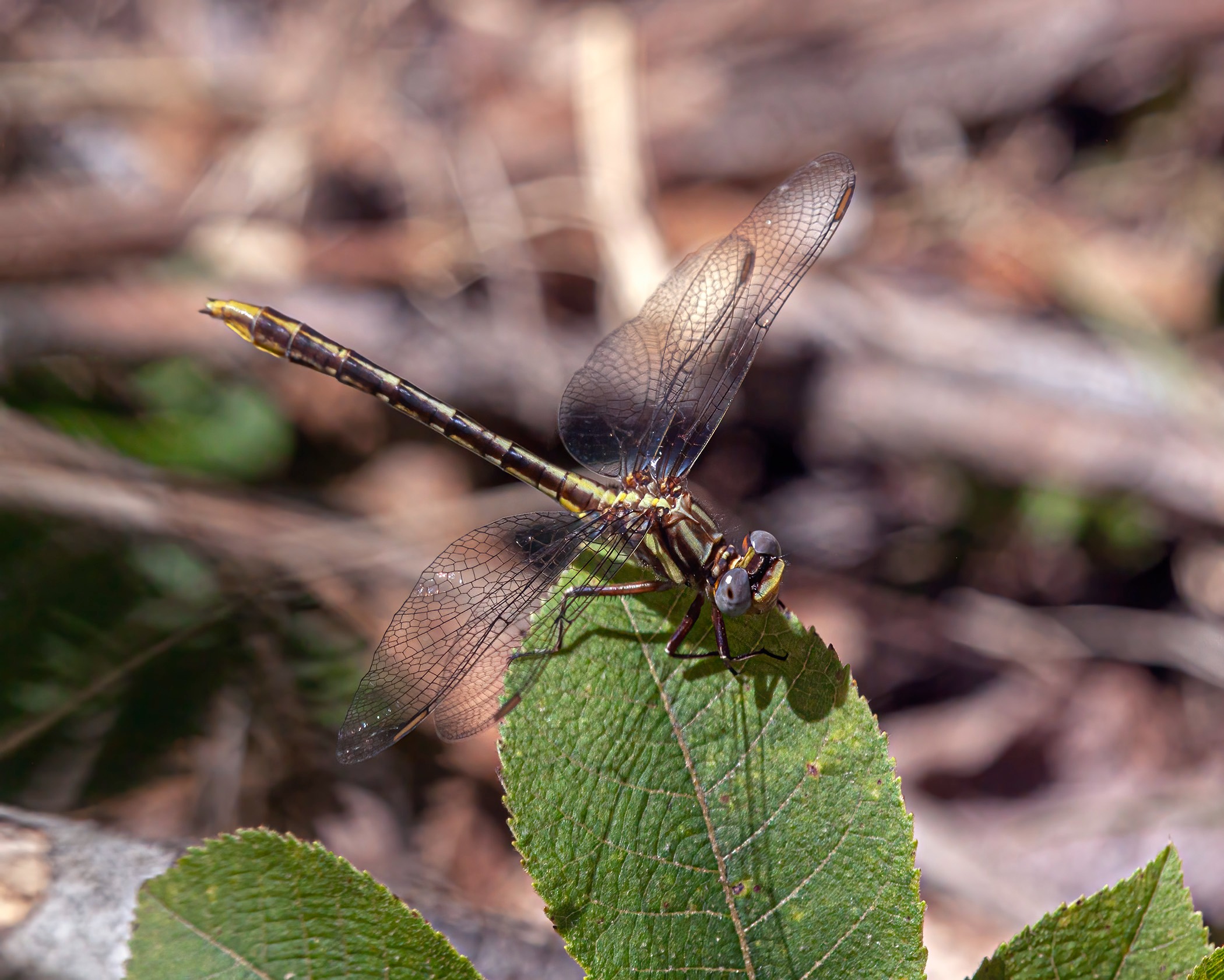
The Lancet Clubtail is a medium-sized dragonfly species in the family Gomphidae, measuring around 1.5 to 1.8 inches (3.8 to 4.5 cm) in length. It is distinguished by the club-shaped widening at the end of the abdomen, typical of clubtails, and its slender body with yellow and black striping. The thorax is olive-green with dark stripes, and the abdomen is mostly yellow with black markings along the dorsal side.
Identification focuses on the distinctive clubbed abdomen, the yellow and black coloration pattern, and the relatively small size for a clubtail. The eyes are widely separated, a common trait in the Gomphidae family, and are greenish to yellowish in color. Wings are clear without markings, held horizontally when perched. This species can be mistaken for other clubtails but can be distinguished by the slender, tapered abdomen and habitat preferences.
Behaviorally, Lancet Clubtails are strong flyers that prefer slow-moving streams, small rivers, and clean, well-vegetated waterways for breeding. They spend much of their time near water but often perch on nearby vegetation or bare ground. Adults hunt flying insects and exhibit swift, direct flight. Males establish territories along stream banks, and females lay eggs in flowing water.
In Massachusetts, the Lancet Clubtail is less commonly encountered but present in suitable habitats statewide. They favor clean, unpolluted streams with sandy or gravelly bottoms, often in forested or semi-wooded areas. Their presence is an indicator of good water quality. Flight season typically extends from late spring to mid-summer, making them a species of interest for dragonfly conservationists and enthusiasts alike.
Common Whitetail (Plathemis lydia)
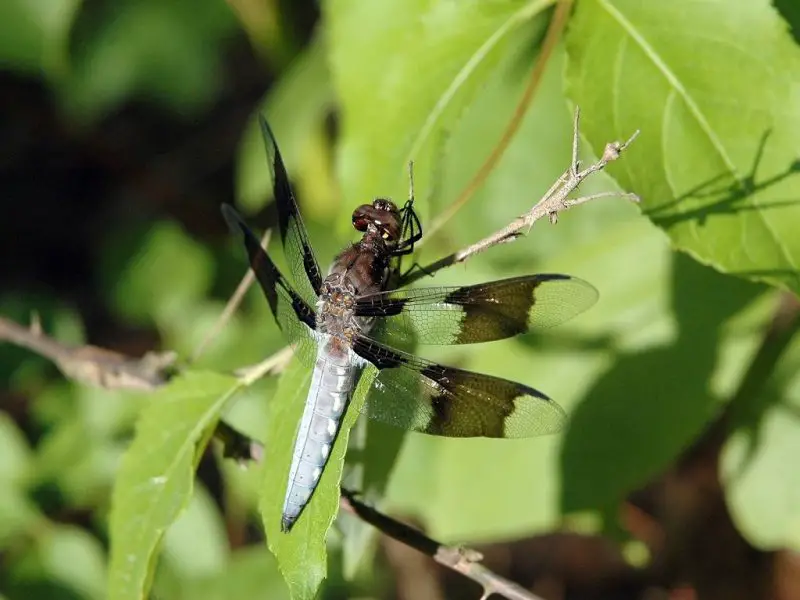
The Common Whitetail is a medium-sized dragonfly belonging to the family Libellulidae, measuring approximately 1.7 to 2 inches (4.3 to 5 cm) in length. It is easily recognizable by the male’s distinctive broad, white abdomen that contrasts with the dark brown to black markings on the thorax and wings. Females have a more mottled brown pattern on the abdomen and are less striking in appearance but still display the characteristic wing venation and shape.
Identification of the Common Whitetail relies heavily on the male’s white abdomen, which resembles a “whitetail” and is often visible from a distance. Both sexes have broad, rounded wings with dark basal bands and clear tips. The thorax is brown with pale stripes, and the eyes are greenish. Females tend to have yellowish markings on the abdomen and more subdued wing coloration, making them slightly more challenging to identify.
Behaviorally, Common Whitetails are aggressive territorial flyers, often seen patrolling over ponds, marshes, and slow-moving waters. Males perch conspicuously on vegetation or bare ground, aggressively chasing intruders and potential rivals. They feed on a wide variety of small flying insects, which they capture with impressive aerial agility. Breeding involves males guarding prime oviposition sites while females lay eggs on submerged vegetation.
In Massachusetts, the Common Whitetail is widespread and common during the warmer months, typically from late spring through early fall. They prefer sunny, still or slow-moving freshwater habitats rich in aquatic plants. Their bold coloration and active behavior make them a favorite subject for dragonfly watchers and photographers throughout the state.
Slaty Skimmer (Libellula incesta)
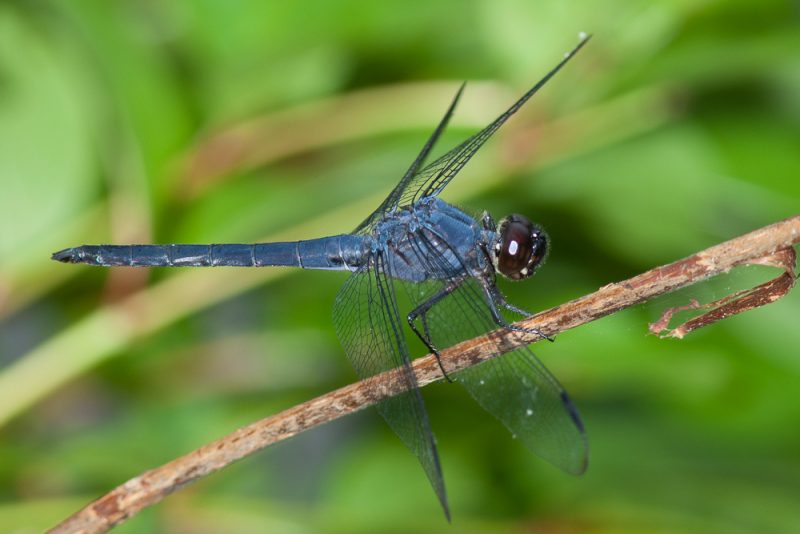
The Slaty Skimmer is a medium to large dragonfly species within the family Libellulidae, measuring around 1.7 to 2 inches (4.3 to 5 cm) in length. Males are notable for their slate-blue coloration that covers the thorax and abdomen, giving the species its name. Females and immature males are brown with yellowish stripes and spots, offering excellent camouflage against vegetation.
Identification of Slaty Skimmers is based on the males’ uniform slate-blue body color and clear wings with slight smoky tints near the base. Females have brown bodies with pale yellow lateral stripes and mottled abdomens. Both sexes have broad, rounded wings and large compound eyes that range from brownish to bluish-green. The species can be confused with other skimmers but is distinguished by its coloration and flight behavior.
Behaviorally, Slaty Skimmers are strong, fast fliers frequently observed patrolling open ponds, lakes, and marshes. Males defend territories vigorously and perform aerial displays to attract females. Their diet consists mainly of flying insects caught in swift flight. They are most active during warm, sunny weather and often perch on exposed twigs or floating vegetation near water edges.
In Massachusetts, Slaty Skimmers are common and distributed throughout the state in suitable freshwater habitats. Their flight season extends from late spring into early fall. They prefer habitats with open, sunny water and abundant emergent plants for egg laying. Their striking coloration and behavior make them a favorite among dragonfly enthusiasts and naturalists.
Striped Saddlebags (Tramea calverti)

The Striped Saddlebags is a medium-sized dragonfly species of the family Libellulidae, measuring about 1.6 to 1.9 inches (4 to 4.8 cm) in length. It is characterized by dark wing patches on the hindwings, known as “saddlebags,” which have distinct lighter stripes or veins running through them, differentiating it from other saddlebags species. The body is slender and primarily reddish-brown or dark with lighter markings.
Identification focuses on the broad dark patches on the hindwings, which have notable striping or vein patterns. The thorax is brownish with lighter stripes, and the abdomen is elongated with reddish hues. Eyes are large and dark, positioned close together. When perched, these dragonflies hold their wings horizontally, prominently displaying their saddlebags.
Behaviorally, Striped Saddlebags are agile fliers commonly seen around ponds, lakes, and marshes. Males are territorial and often patrol water edges, defending breeding areas against rivals. They feed primarily on small flying insects and are most active during sunny, warm days. Their graceful gliding flight combined with distinctive wing markings makes them easy to spot.
In Massachusetts, Striped Saddlebags are less common than some other skimmers but present in wetland habitats throughout the state. Their flight period typically spans from early summer to early fall. They favor warm, open aquatic environments with ample vegetation, contributing to the diversity of dragonflies in the region.
Prince Baskettail (Epitheca princeps)
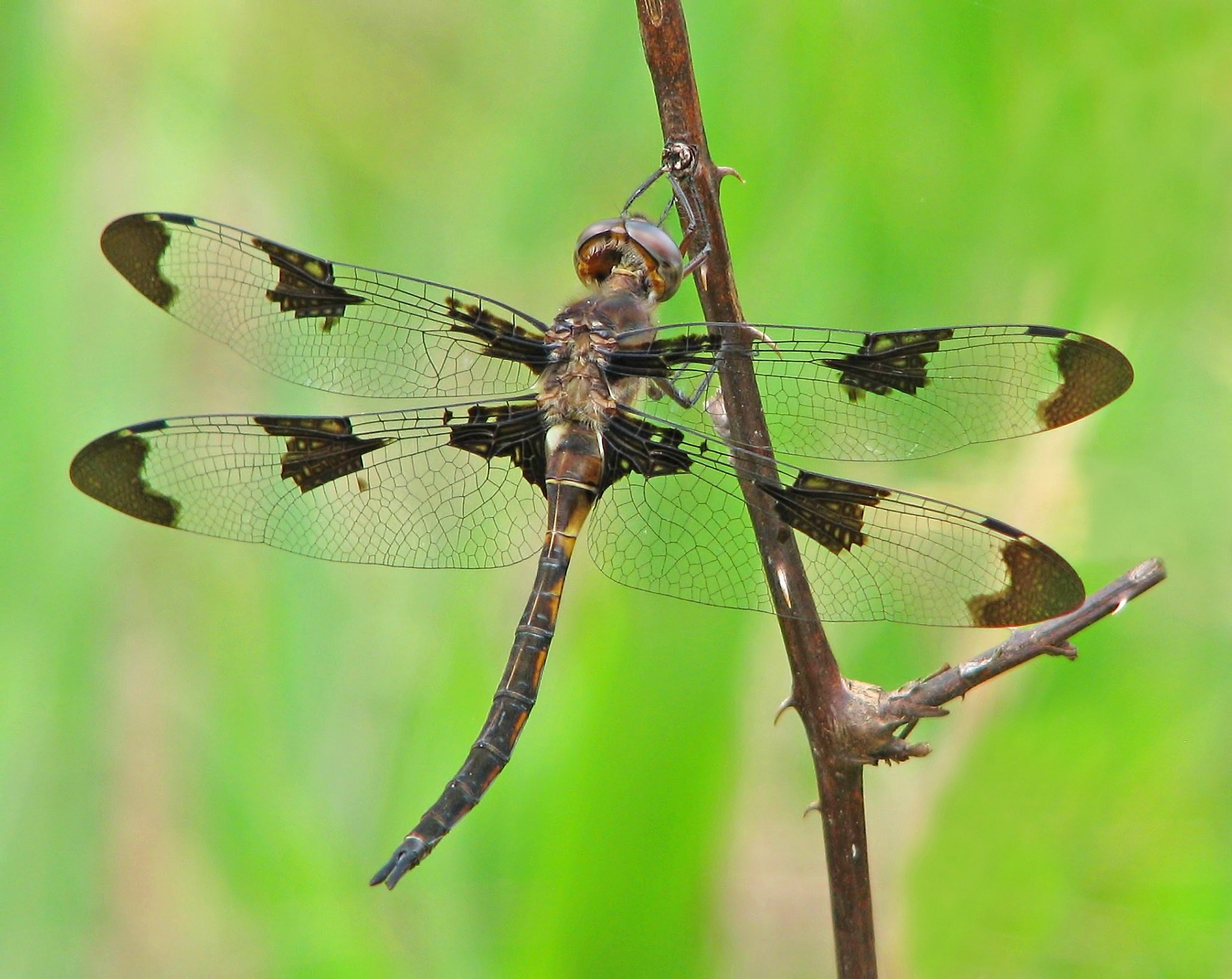
The Prince Baskettail is a medium-sized dragonfly species belonging to the family Corduliidae, measuring approximately 1.6 to 1.9 inches (4 to 4.8 cm) in length. It is recognized by its slender, elongated body with dark brown or black coloration accented by yellow or greenish-yellow markings on the thorax and abdomen. The wings are clear with a slight amber tint near the base.
Identification of the Prince Baskettail involves noting its long, slender abdomen with pale markings and the distinctively patterned thorax. Eyes are large, bright green, and set close together, characteristic of the emerald dragonfly family. The wings lack distinctive markings but may show a subtle amber wash. This species can be confused with other baskettails but is distinguishable by its size and coloration.
Behaviorally, Prince Baskettails are agile flyers often found near streams, ponds, and lakes with clean water and abundant vegetation. They perch on reeds or low branches and actively hunt small flying insects. Males establish and defend territories during the breeding season, performing aerial displays to attract females. Their flight season is mainly in late spring and summer.
In Massachusetts, the Prince Baskettail is distributed statewide in suitable habitats, including clean ponds and slow rivers. They prefer well-vegetated water bodies for breeding and are indicators of healthy aquatic ecosystems. Observers can spot them from late May through August, where they contribute to the rich dragonfly fauna of the region.
Hudsonian Whiteface (Leucorrhinia hudsonica)

The Hudsonian Whiteface is a small dragonfly species from the family Libellulidae, measuring about 1.1 to 1.3 inches (2.8 to 3.3 cm) in length. It is notable for its mostly black body contrasted with striking white markings on the face and thorax. The wings are clear with dark spots near the base, and the abdomen has distinct pale spots on the dorsal side.
Identification relies on the distinctive white facial markings, which give the species its common name, as well as the contrasting black and white pattern on the thorax and abdomen. The eyes are dark brown, and the wings have dark basal spots on both forewings and hindwings. Females and males have similar markings but females tend to be slightly larger.
Behaviorally, Hudsonian Whitefaces are often seen flying low over ponds, bogs, and marshy areas, preferring cooler climates and shaded waters. They exhibit a quick, darting flight and often perch on vegetation near the water’s edge. Their diet consists mainly of small flying insects. Mating involves males guarding territories and females depositing eggs on submerged plants.
In Massachusetts, Hudsonian Whitefaces are more common in northern and western parts of the state where cooler habitats prevail. They are typically active from late spring to mid-summer and prefer acidic, nutrient-poor wetlands such as bogs. Their presence indicates healthy wetland ecosystems, making them of interest to conservationists and naturalists alike.


